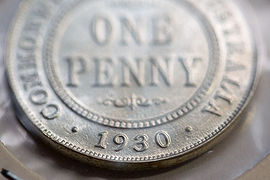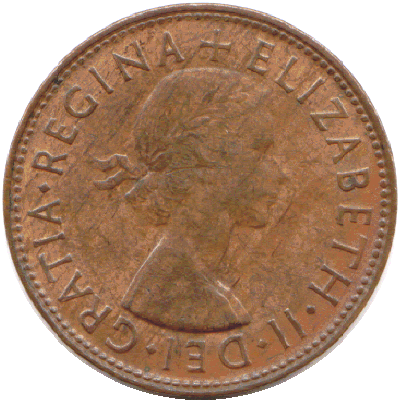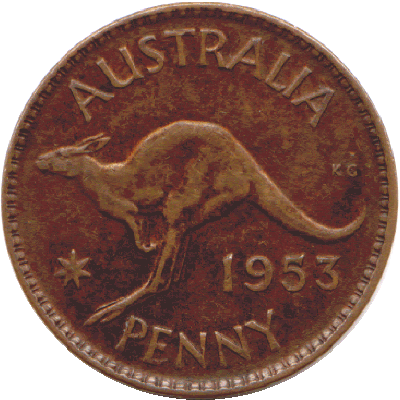
Penny (Australian)
Encyclopedia
The Australian Penny was a coin of the Australian pound
used in the Commonwealth of Australia prior to decimalisation in 1966. It was worth one twelfth of an Australian shilling
and 1/240 of an Australian pound. The coin was equivalent in its dimensions, composition and value to the British penny, as the two currencies were fixed at par.
The coin was first introduced in 1911, and stopped being minted in 1964, with the introduction of decimalisation
. When decimalisation happened on 14 February 1966, the coin value was equal to 0.8333¢.
The obverse of the coin featured the reigning British monarch. Three were featured: George V
, George VI and Elizabeth II. All of the pennies featuring George VI and Elizabeth II had a kangaroo on the reverse. The same image was on the Australian half-penny and has since been included on the dollar coin and the bullion silver kangaroo.
 The 1930 penny is one of the rarest Australian coins, due to a very small number being minted.
The 1930 penny is one of the rarest Australian coins, due to a very small number being minted.
It is highly sought after by coin collectors
, and a 1930 penny in very fine
condition can be worth A$45,000 or more.
Australian pound
The pound was the currency of Australia from 1910 until 13 February 1966, when it was replaced by the Australian dollar. It was subdivided into 20 shillings, each of 12 pence.- Earlier Australian currencies :...
used in the Commonwealth of Australia prior to decimalisation in 1966. It was worth one twelfth of an Australian shilling
Shilling (Australian)
The Australian Shilling was a coin of the Commonwealth of Australia prior to decimalization. The coin was minted from 1910 until 1963, excluding 1923, 1929, 1930, 1932, 1938, 1947, 1949 and 1951...
and 1/240 of an Australian pound. The coin was equivalent in its dimensions, composition and value to the British penny, as the two currencies were fixed at par.
The coin was first introduced in 1911, and stopped being minted in 1964, with the introduction of decimalisation
Decimalisation
Decimal currency is the term used to describe any currency that is based on one basic unit of currency and a sub-unit which is a power of 10, most commonly 100....
. When decimalisation happened on 14 February 1966, the coin value was equal to 0.8333¢.
The obverse of the coin featured the reigning British monarch. Three were featured: George V
George V
George V was king of the United Kingdom and its dominions from 1910 to 1936.George V or similar terms may also refer to:-People:* George V of Georgia * George V of Imereti * George V of Hanover...
, George VI and Elizabeth II. All of the pennies featuring George VI and Elizabeth II had a kangaroo on the reverse. The same image was on the Australian half-penny and has since been included on the dollar coin and the bullion silver kangaroo.
Types
| Image | Years | Technical parameters | Description / Legend / Designer | |||||||
|---|---|---|---|---|---|---|---|---|---|---|
| Obverse | Reverse | From | To | Diameter | Thickness | Mass | Composition | Edge | Obverse | Reverse |
 |
 |
1911 | 1936 | 30.8 mm | 9.45 g | Bronze Bronze Bronze is a metal alloy consisting primarily of copper, usually with tin as the main additive. It is hard and brittle, and it was particularly significant in antiquity, so much so that the Bronze Age was named after the metal... : Cu Copper Copper is a chemical element with the symbol Cu and atomic number 29. It is a ductile metal with very high thermal and electrical conductivity. Pure copper is soft and malleable; an exposed surface has a reddish-orange tarnish... 97.5%, Zn Zinc Zinc , or spelter , is a metallic chemical element; it has the symbol Zn and atomic number 30. It is the first element in group 12 of the periodic table. Zinc is, in some respects, chemically similar to magnesium, because its ion is of similar size and its only common oxidation state is +2... 2.0%, Sn Tin Tin is a chemical element with the symbol Sn and atomic number 50. It is a main group metal in group 14 of the periodic table. Tin shows chemical similarity to both neighboring group 14 elements, germanium and lead and has two possible oxidation states, +2 and the slightly more stable +4... 0.5% |
Plain | George V George V of the United Kingdom George V was King of the United Kingdom and the British Dominions, and Emperor of India, from 6 May 1910 through the First World War until his death in 1936.... GEORGIVS V D.G.BRITT: OMN: REX F.D. Fidei defensor Fidei defensor is a Latin title which translates to Defender of the Faith in English and Défenseur de la Foi in French... IND:IMP: Emperor of India Emperor/Empress of India was used as a title by the last Mughal emperor Bahadur Shah II, and revived by the colonial British monarchs during the British Raj in India.... by Bertram Mackennal |
ONE PENNY COMMONWEALTH OF AUSTRALIA by W.H.J. Blakemore |
|
 |
 |
1938 | 1948 | George VI GEORGIVS VI D:G:BR:OMN:REX: F:D:IND:IMP. by Thomas Hugh Paget |
Kangaroo Kangaroo A kangaroo is a marsupial from the family Macropodidae . In common use the term is used to describe the largest species from this family, especially those of the genus Macropus, Red Kangaroo, Antilopine Kangaroo, Eastern Grey Kangaroo and Western Grey Kangaroo. Kangaroos are endemic to the country... / Commonwealth Star Commonwealth Star The Commonwealth Star is a seven-pointed star symbolising the Federation of Australia which came into force on 1 January 1901.... AUSTRALIA ONE PENNY by George Kruger Gray George Kruger Gray George Edward Kruger Gray was an English artist, best remembered for his designs of coinage and stained glass windows.-Coinage:... |
|||||
 |
 |
1949 | 1952 | George VI GEORGIVS VI D:G:BR:OMN:REX FIDEI DEF. Fidei defensor Fidei defensor is a Latin title which translates to Defender of the Faith in English and Défenseur de la Foi in French... by Thomas Hugh Paget |
||||||
 |
 |
1953 | 1953 | Elizabeth II + ELIZABETH.II.DEI.GRATIA.REGINA Dei Gratia Regina Dei Gratia Regina is Latin for By the Grace of God, Queen. This phrase appears on the obverse of all Canadian coins to the right of the portrait of Queen Elizabeth II.... by Mary Gillick Mary Gillick Mary Gillick was a sculptor best known for her effigy of Elizabeth II used on coinage in the United Kingdom and elsewhere from 1953 to 1967.... |
||||||
 |
 |
1955 | 1964 | Elizabeth II + ELIZABETH.II.DEI.GRATIA.REGINA.F:D: by Mary Gillick Mary Gillick Mary Gillick was a sculptor best known for her effigy of Elizabeth II used on coinage in the United Kingdom and elsewhere from 1953 to 1967.... |
||||||
Numismatics

It is highly sought after by coin collectors
Coin collecting
Coin collecting is the collecting or trading of coins or other forms of minted legal tender.Coins of interest to collectors often include those that circulated for only a brief time, coins with mint errors and especially beautiful or historically significant pieces. Coin collecting can be...
, and a 1930 penny in very fine
Coin grading
In coin collecting coin grading is the process of determining the grade or condition of a coin, one of the key factors in determining its value as a collector's item....
condition can be worth A$45,000 or more.

